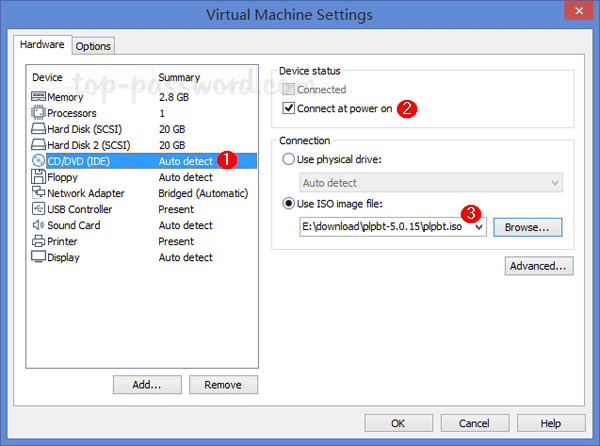

The source tutorial continues to explain how to actually boot to a USB device in more detail but that isn't what you are trying to do. Get around that limitation, by using the PLoP Boot Manager. VMWare’s BIOS does not allow you to boot to a USB device, but you can Pressing the “+” key to move items up on the list, and the “-” key to Switch to the Boot tab, and change the ordering of the items by

Once you have access to the BIOS setup you can change the boot order permanently by doing the following. Note: Other documentation indicates the actually maximum delay is 20 seconds or 20000 milliseconds. Milliseconds in a second.) The maximum value for the boot delay is Number of milliseconds to show the POST screen. This adds a delay to the initial POST screen, showing it for longerĪnd giving you more time to access the BIOS setup, where xxxx is the This forces entry to the BIOS setup at startup. Machine's configuration (.vmx) and add or edit one of these options: To make it easier to access the BIOS setup screen, edit the virtual You can do the following to make your job easier. "Power on to firmware" is the new name for "Power on to BIOS" since some VMs now use EFI instead of BIOS. (or "power on to bios" in other VMware workstation versions). Oddly, while in an ubuntu VM, F2 and ESC don't bring up the BIOS, choosing "power on to firmware" does. In my version it's "power on to firmware" but it goes to the BIOS And in some versions of vmware workstation it's "power on to BIOS". To move CD ROM Drive to the top, highlight CD ROM Drive with the arrow key, and then press the + (plus sign) until CD ROM Drive is at the top of the list. In the BIOS menu, navigate to the 'Boot' section. It's in the menu when right clicking a VM, or in the VM menu at the top. In the remote console, when the VMware startup screen appears, wait for the BIOS menu to appear. When practicing you might want to shutdown and power up, rather than restart, so it's a bit clearer when it is powering up, though restarting is OK.Īnother option is "power on to firmware", try it, it goes to the BIOS.

But if you've been missing it you might appreciate the screen being there for 15 seconds, then change it once you've figured out how to do it. You might want to shorten it from 15 seconds. You can also edit the vmx file of the virtual machine, and add the line bios.bootDelay = "15000" (15000 milliseconds is 15 seconds but you can change it to whatever) and you get another screen that offers the same keys and a 15 second delay to hit them. When the virtual machine starts, the mouse cursor changes from an arrow to a hand cursor, but you are not in the virtual machine unless you click, and then the cursor will disappear. You have to mouse click to enter the VM, and then hit the key (F2 for BIOS or ESC for boot. You have to mouse click to enter the VM, and then hit the key (F2 for BIOS or ESC for boot menu) F12 for network boot though I haven't used network boot. Youre right to act as soon as it starts, but dont just hit a key. You're right to act as soon as it starts, but don't just hit a key.


 0 kommentar(er)
0 kommentar(er)
